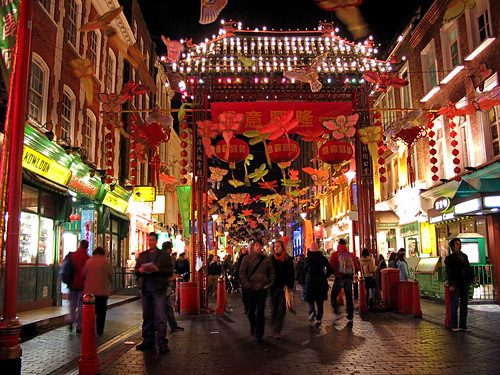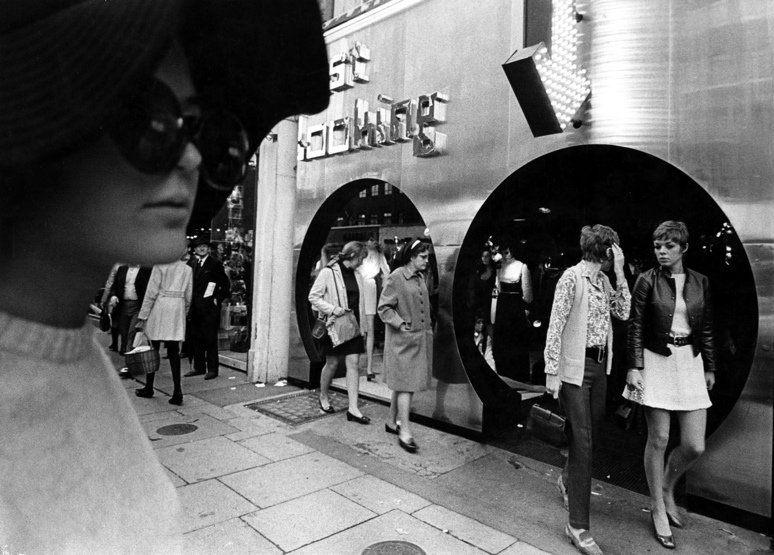
In truth, while there's some validity to the argument that prices for certain goods are higher than elsewhere.
For major international and British Brands, London's main shopping areas tend to centre around Oxford Street and Regent Street, while Knightsbridge is home to stores stocking even more upmarket goods. Anyone looking for specialist items should head to Covent Garden, whilst those with serious money to spend gravitate towards New Bond Street (home to some of Britain's most exclusive shops). If you're after bargain electrical goods Tottenham Court Road is a must, while Hatton Garden is the place to go for watches and jewellery.
London Favourite streets
♥ OXFORD STREET
Oxford Street is one and a half miles end to end. Most shops open 10am until 6 or 7pm. Some open Sunday 12 to 6pm with late nights on Thursday. Oxford Street is best known for Selfridges and the other big department stores which are all found in the section from Marble Arch to Oxford Circus, along with most of the big-name multinationals. It's more of the same as you continue towards Tottenham Court Road, but generally on a smaller scale. Oxford Street is said to be the busiest shopping street in Europe.
 ♥ REGENT STREET
♥ REGENT STREET Regent Street forms a neat dividing line between swanky Mayfair to the West and trendy Soho to the East. The main shopping section of the street lies between Oxford Circus to the north, and Piccadilly Circus to the south - a distance of about 3/4 of a mile. Our panoramas will help you see what's on offer, especially as the shops here can all appear rather uniform due to the regulations that they must blend in with the elegant architecture of the street. Regent Street has similar shop opening hours to Oxford Street.
♥ COVENT GARDEN AND SEVEN DIALS
In general, for best selection of shoe shops and independent fashion outlets, head towards the area called 'Seven Dials' (top map) by going to the left when you leave covent Garden station (cross over the road and then go around the side of Marks and Spencer into Neal Street). Turning right when you leave the station (bottom map) leads to the Piazza and the Market Hall where you can find the widest choice of cafes and restaurants plus the street entertainment for which Covent Garden is well known.
♥ BOND STREET 
Bond Street in Mayfair is home to the most elegant and expensive shops in London. Designer clothing such as Gucci and Armani; perfume; art and antiques; and more Royal Warrant holders (suppliers to the royal family) than anywhere else in London. New Bond Street is a few minutes walk from Bond Street Station, connected by pedestrian-only South Molton Street, and Old Bond Street is the short section at the Southern end which joins Piccadilly.
♥ PICCADILLY AND JERMYN STREET
Piccadilly is the wide and busy main road that leads to Picccadilly Circus. It is home to the The Ritz Hotel and the Fortnum and Mason department store which has stood at the same site for almost three hundred years. The Royal Academy art institute is on the northside of Piccadilly at Burlington House. Parallel to Piccadilly to the south, is quieter Jermyn Street with its long-established menswear shops, especially shirtmakers.

 ♥ SOHO AND CHINATOWN
♥ SOHO AND CHINATOWN
With all the bars and restaurants, Soho attracts a capacity crowd after work and especially on Friday and Saturday nights. During the day Soho is more about coffee bars and cafes rather than the sex shops for which the area was once known. Old Compton Street is Soho's 'High Street' and also London's most prominent gay area. The area near Leicester Square is London's Chinatown.
♥ CARNABY STREET
Carnaby is the cheerful pedestrianised area in north Soho just behind Regent Street. The area has seen a lot of changes in the last few years, especially at the southern end of Carnaby Street, where in addition to a number of new stores, there is now a passage through to Kingly Court with three floors of one-off 'concept' shops and studios where it is possible to find items not sold anywhere else in London.
♥ MARYLEBONE HIGH STREETAND ST. CHRISPOPHER'S PLACE
Marylebone is the area to the North of Oxford Street. It is a ten minute walk to the High Street from Bond Street station via pedestrian-only St Christopher's Place (use the hidden alleyway to the left of the H&M store). Nearby Chiltern Street is a quieter street notable for the high number of specialist women's outfitters. Marylebone High Street often wins praise for its character and the ideal mix of shops and restaurants.
♥ TOTTENHAN COURT ROAD
In general, Tottenham Court Road divides neatly into electronics shops in the southern half (Oxford Street end), and home furnishing stores in the northern half (Warren Street end). Nearby Charlotte Street is a popular place to eat, with plenty of restaurants on both sides.
♥ EDGWARE ROAD
The section of Edgware Road near to Marble Arch is famous for its distinctive Middle-Eastern character. Lebanese restaurants, shisha cafes and clubs line both sides of the road, with some staying open late into the night. Marble Arch station is a few minutes walk from the southern end of Edgware Road.

 ♥ KING'S ROAD
♥ KING'S ROAD
The curved facade of Peter Jones department store marks the start of the King's Road at Sloane Square. Nearby, on the opposite side of the road is the Duke of York pedestrian precinct and the Saatchi art gallery. The further away from Sloane Square you walk, the greater the number of smaller, independent clothes and shoe shops there are, plus a good selection of contemporary furnishing stores.
♥ KNIGHTSBRIDGE
Knightsbridge is best known for Harrods and Harvey Nichols department stores. When you leave the tube, you can take a pedestrian tunnel that goes from the platform directly to Harrods' entrance, or you can use the other exit for Sloane Street and Harvey Nichols. Most of the big-name fashion designers can be found on Sloane Street, but if you prefer equally elegant shops on a smaller scale, head for Beauchamp Place and Walton Street.

♥ PORTOBELLO ROAD // NOTTING HILL
The weekend Portobello Road Market is the reason why most people visit Notting Hill. The section of the market that lies north of the flyover (plus Golborne Road) is mostly bric-a-braq, while clothes and food stalls are in the middle section. Antiques and collectibles are at the southern end, nearest to Notting Hill Gate tube station. During the week the area is more peaceful and most of the 'non-antique' shops you see in the panoramas are open normal hours.
♥ UPPER STREET, ISLINGTON
The antique shops and market (Camden Passage) are a few minutes walk from Angel tube station, on the same side of the street going up towards Islington Green. For Chapel market (the local street market) and for the N1 shopping centre, cross over Upper Street on leaving the station, and walk down Liverpool Road. Upper Street is Islington's high street. There is an abundance of restaurants and bars (and estate agents). The Exhibition Hall is a third of the way up, near to Islington Green and the junction with Essex Road.
♥ FULHAM ROAD
Fulham Road goes out towards Fulham from South Kensington, running parallel to the King's Road to the south. The area called Brompton Cross can be found at number1 on the diagram below. There are plenty of antique dealers and specialist interior furnishing stores which give Fulham Road a rather sedate atmosphere.
 ♥ CAMDEN TOWN
♥ CAMDEN TOWN
Camden Town is famous for the four markets - Camden Market, Camden Lock Market, Camden Canal Market and Stables Market - all selling vintage clothing, street fashion, antiques and arts and crafts. Plenty of leatherwear and body piercing too. Extremely busy at weekends.

♥ ST JOHN'S WOOD HIGH STREET
Self-contained and prosperous, the St John's Wood High Street is a reflection of the area's demographics. Parking is still permitted here, which leads to the street often being clogged with motorists waiting for an available space. The tube station is five minutes walk. There is a high proportion of independent retailers in the High Street.
♥ QUEENSWAY
This area of Bayswater is well-known for its high number of hotels, so Queensway largely caters for tourists, with plenty of souvenir shops, bureaux de change and fast food restaurants, especially near the southern end. The top end of Queensway is dominated by the huge Whiteleys shopping centre where many of the familiar high street names can be found, together with a choice of restaurants and a multi-screen cinema.
Brick Lane runs from Spitalfields at the North end down to Aldgate at the South. In addition to its fascinating history, the street is best known for the sprawling market that takes place every Sunday (North of the old brewery) and also for the unrivalled choice of Bangladeshi restaurants that you can find along its length. Other markets nearby are Spitalfields and UpMarket, both indoors. The Old Truman Brewery, about half way up Brick Lane, is now home to a lively media / fashion / arts scene, with the buildings converted to studios and workspace.
♥ HARRODS
The store occupies a 4.5-acre (18,000 m2) site and has over one million square feet (90,000 m2) of selling space in over 330 departments. The UK's second-biggest shop, Oxford Street's Selfridges, is a little over half the size with 540,000-square-foot (50,000 m2)[1] of selling space.
The Harrods motto is Omnia Omnibus Ubique — All Things for All People, Everywhere. Several of its departments, including the seasonal Christmas department and the Food Hall, are world famous.


No hay comentarios:
Publicar un comentario